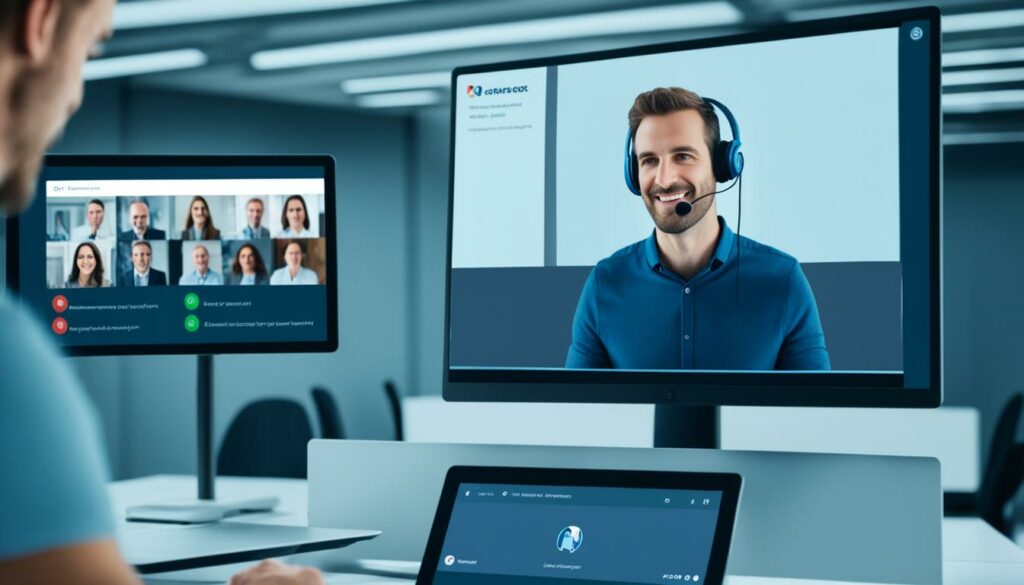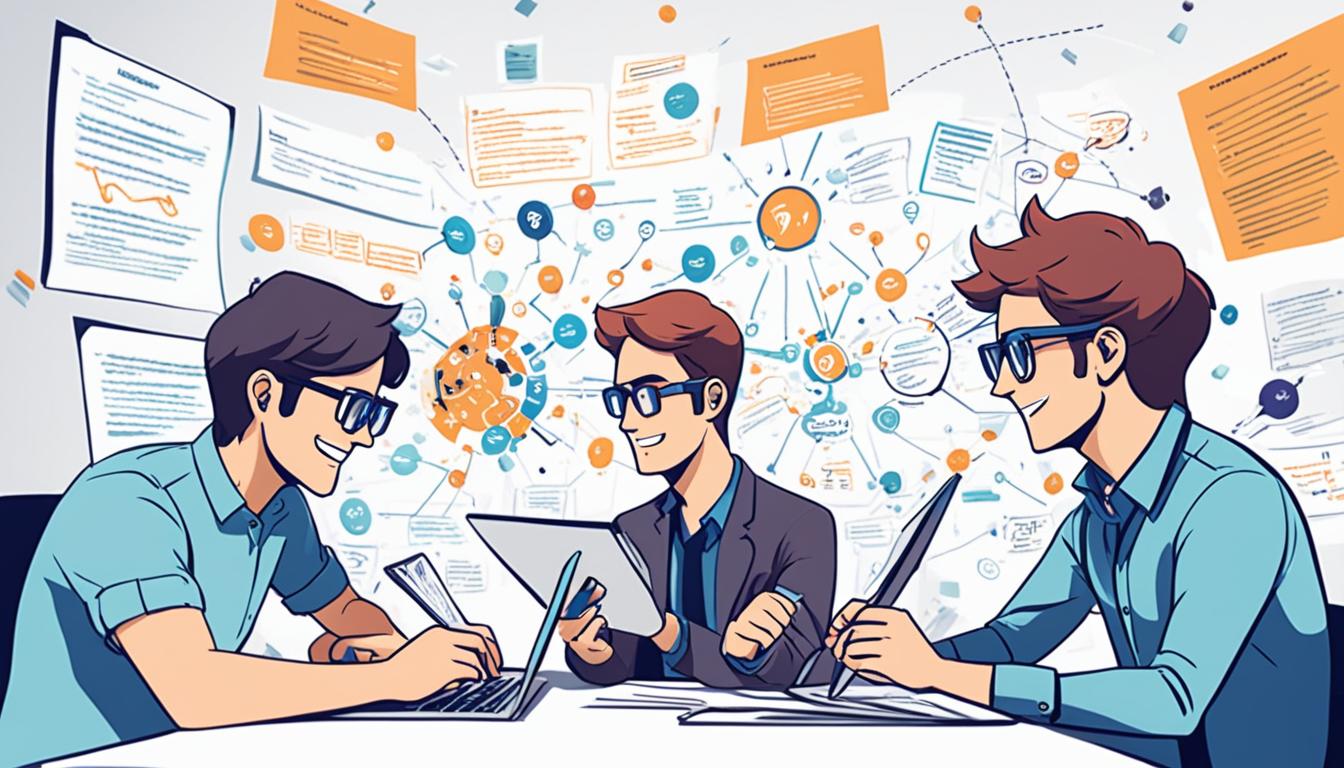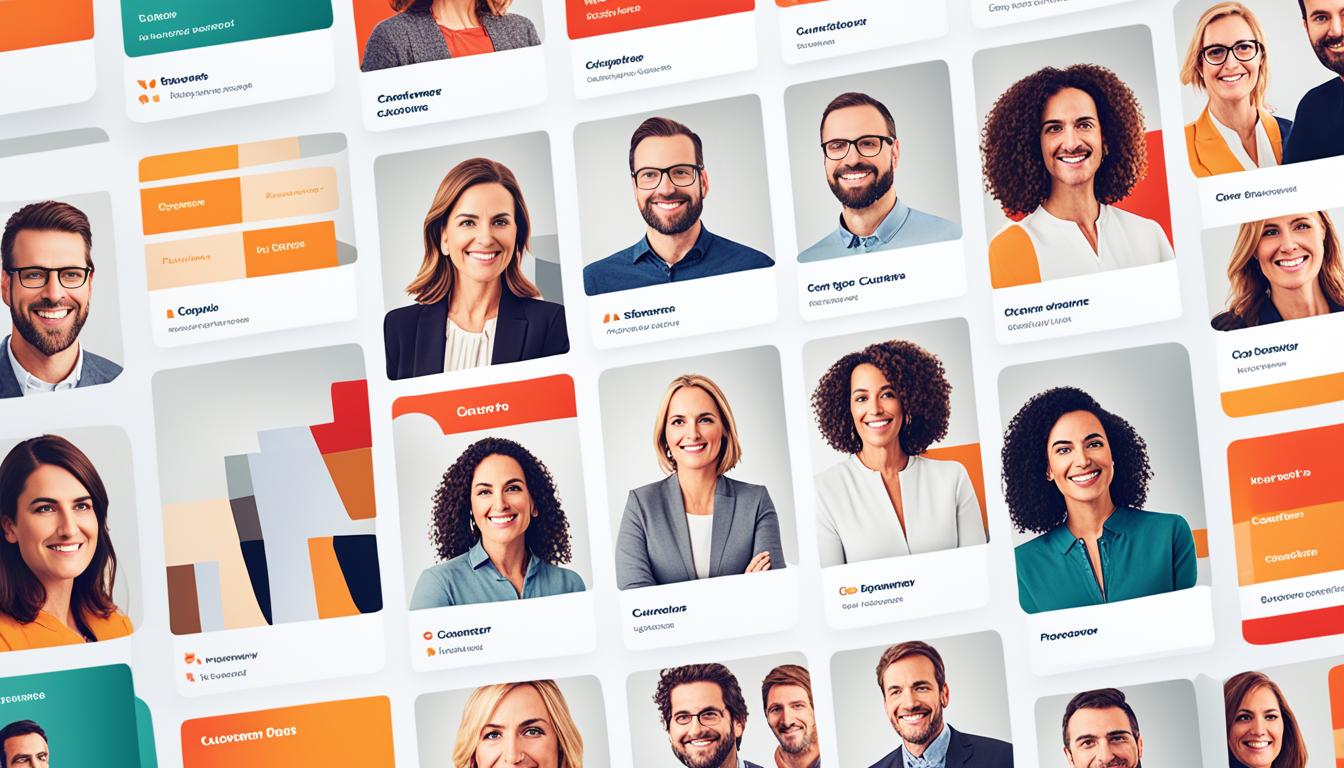
“Harnessing the Power of Speech-to-Text for More Productive Meetings””

As technology continues to advance, so does our ability to leverage it for increased productivity in various aspects of our lives. The world of meetings and conferences is no exception. With the advent of speech recognition technology, we now have the power to transcribe meetings accurately and efficiently, revolutionizing the way we communicate and collaborate.
“Technology is best when it brings people together.”
– Matt Mullenweg
Speech-to-text technology has the potential to transform meetings, making them more streamlined and productive than ever before. By harnessing this technology, we can improve meeting efficiency, enhance communication, and streamline meeting documentation. Whether in-person or virtual, the power of speech-to-text is being harnessed to create a more productive meeting environment.
The Benefits of Speech Recognition Technology in Meetings
Speech recognition technology in meetings offers several advantages that can significantly improve meeting efficiency and productivity. By harnessing the power of speech-to-text technology, participants can streamline their note-taking process and enhance communication in real-time. The accurate transcription of meetings facilitates comprehensive documentation, ensuring that no valuable information gets overlooked. Let’s explore the key benefits provided by speech recognition technology in meetings:
1. Improve Meeting Efficiency
Speech recognition technology eliminates the need for manual note-taking during meetings, allowing participants to focus fully on the discussion at hand. By dictating their notes, participants can save significant time and increase their engagement in the meeting.
2. Accurate Note-taking
Manual note-taking can be prone to human error, leading to missed details or inaccuracies. Speech recognition technology ensures accurate and detailed note-taking by transcribing speech into text with high precision and reliability.
3. Real-time Transcription
In a fast-paced meeting environment, real-time transcription provided by speech recognition technology allows participants to access meeting notes instantly. This feature enables seamless referencing and follow-up on action items, promoting efficient collaboration and decision-making.
4. Enhanced Communication
Speech recognition technology fosters enhanced communication by allowing participants to interact naturally with technology. Instead of interrupting the flow of conversation to take notes, participants can speak freely, resulting in a more collaborative and productive meeting environment.
5. Streamlined Documentation
Automated transcription of meetings streamlines the documentation process, saving time and effort. The comprehensive records generated by speech recognition technology serve as reliable references for future use, ensuring that no essential information is lost or forgotten.
By utilizing speech recognition technology in meetings, organizations can unlock the true potential of their collaborative efforts, improve meeting efficiency, and streamline documentation for informed decision-making. Embracing this technology offers a seamless and effective way to optimize meeting outcomes.
Transforming Virtual Meetings with Speech-to-Text Technology
Virtual meetings have become increasingly common, and speech-to-text technology can greatly enhance their efficiency and effectiveness. By utilizing speech recognition technology, participants can improve virtual meeting efficiency by transcribing discussions and ensuring accurate virtual meeting transcription. This eliminates the need for manual note-taking, allowing participants to fully engage in the meeting without the distraction of capturing every detail.
Speech-to-text technology also enhances virtual communication by providing real-time transcription during virtual meetings. Participants can easily follow along and understand the discussion, leading to better collaboration and improved meeting outcomes. The accurate transcriptions also serve as a valuable reference for future conversations and decisions, streamlining virtual meeting documentation.
“Speech-to-text technology has revolutionized the way we conduct virtual meetings. It has eliminated the tedious task of note-taking, allowing us to fully focus on the discussion at hand. The real-time transcription feature ensures that nothing gets lost in translation, resulting in more productive and efficient meetings.”
With automated transcription, virtual meetings become more streamlined and organized. The comprehensive records captured by speech-to-text technology can be easily accessed and referred to later, ensuring that no important information is overlooked. This not only saves time but also enhances the overall virtual meeting experience by promoting a more structured and effective approach to collaboration.
As technology continues to advance, speech-to-text technology will play an increasingly vital role in transforming virtual meetings. Its ability to improve virtual meeting efficiency, provide accurate virtual meeting transcription, enhance virtual communication, and streamline virtual meeting documentation is invaluable in today’s fast-paced and digitally-driven world. Embracing this technology can lead to more productive, engaging, and successful virtual meetings.
So, why settle for traditional virtual meetings when you can leverage the power of speech-to-text technology to revolutionize your virtual communication? Harness the potential of speech recognition and take your virtual meetings to the next level of efficiency and effectiveness.
Benefits of Speech-to-Text Technology in Virtual Meetings
| Benefits | Description |
|---|---|
| Improved Efficiency | Eliminates manual note-taking, allowing full engagement in the meeting |
| Enhanced Communication | Real-time transcription facilitates better understanding and collaboration |
| Accurate Transcription | Detailed records for reference and decision-making |
| Streamlined Documentation | Easily accessible and organized meeting records |
Enhancing Collaboration and Accessibility with Speech-to-Text
Speech-to-text technology plays a crucial role in enhancing collaboration and accessibility in meetings. By providing accurate and accessible meeting documentation, this technology enables participants to review discussions and collaborate more effectively on tasks and projects. Whether in-person or virtual meetings, speech-to-text transcriptions serve as valuable references and ensure that no important information is missed.
This technology also promotes inclusivity by ensuring that meeting documentation is accessible to all participants, including those with hearing impairments. By providing real-time transcriptions, speech-to-text allows hearing-impaired individuals to actively participate in meetings, improving their understanding and involvement.
With speech-to-text technology, organizations can create a more inclusive and collaborative meeting environment by eliminating communication barriers. Participants can rely on the transcriptions to follow discussions, contribute meaningfully, and work together towards common goals. This technology not only improves meeting participation but also strengthens teamwork and overall meeting outcomes.
“Speech-to-text technology enables inclusive meetings by providing accessible documentation to all participants, regardless of their hearing abilities.”
Improved Meeting Participation
Speech-to-text technology enhances meeting participation by creating an environment where everyone can actively contribute. Hearing-impaired individuals no longer have to depend solely on lip-reading or sign language interpreters to understand the discussion. Instead, they can read the real-time transcriptions, allowing them to engage more actively and meaningfully in meetings.
Moreover, speech-to-text technology reduces the dependency on note-taking during meetings. Participants no longer need to divert their attention to writing or typing notes, which often leads to missed information or ineffective multitasking. By providing accurate transcriptions, this technology enables participants to focus on the conversation and actively contribute to the meeting. This ultimately leads to improved meeting participation and more productive outcomes.
Inclusive Meetings for All
Speech-to-text technology truly transforms meetings into inclusive spaces where everyone can fully participate. By providing accessible meeting documentation, this technology breaks down barriers and ensures equal access for all participants. Hearing-impaired individuals no longer face the challenge of understanding spoken discussions – they can simply read the transcriptions in real-time.
This inclusivity extends beyond hearing impairments. Speech-to-text technology also benefits individuals who process information better by reading rather than listening. By catering to various learning and communication preferences, organizations can create a more inclusive and diverse meeting culture.
Collaboration with Accessibility
Collaboration is at the heart of successful meetings, and speech-to-text technology enhances this collaboration by providing accurate and accessible meeting documentation. Participants can rely on the transcriptions to review discussions, clarify details, and collaborate on tasks and projects effectively.
To illustrate the benefits of collaboration with speech-to-text technology, consider the following example:
| Traditional Meeting | Meeting with Speech-to-Text |
|---|---|
| Participants take handwritten or typed notes, which might leave gaps or be incomplete. | Accurate real-time transcriptions capture all discussions, ensuring a comprehensive record. |
| Participants need to ask for clarification and repeat information, leading to potential misunderstandings. | Transcriptions provide clarity and eliminate the need for repeated information. |
| Reviewing handwritten or typed notes can be time-consuming and prone to errors. | Transcriptions serve as searchable and easily accessible meeting documentation, saving time and effort. |
Table: Comparison of a traditional meeting and a meeting with speech-to-text technology.
By embracing speech-to-text technology, organizations can foster a collaborative meeting culture where participants can fully engage and contribute. This technology not only enhances collaboration but also promotes accessibility and inclusivity for all meeting participants.
The Future of Speech-to-Text Technology in Meetings
As advancements in speech recognition technology continue, the future of speech-to-text technology in meetings looks incredibly promising. With the power of AI-powered transcription algorithms becoming more sophisticated, we can expect improved accuracy and faster transcription speeds.
One exciting development is the ability to achieve real-time language translation during meetings. This breakthrough has the potential to break down language barriers and facilitate global collaboration. Participants from different countries and language backgrounds can communicate seamlessly, leading to enhanced understanding and productivity.
With continued technological advancements, speech-to-text technology is predicted to become an essential tool in meetings. Its ability to provide instant and accurate documentation ensures that important discussions, decisions, and action items are captured effectively. The improved accuracy and efficiency of speech recognition technology will enhance communication and collaboration, allowing meetings to be more productive than ever before.
Advancements in Speech Recognition and AI-Powered Transcription
“The continuous advancements in speech recognition and AI-powered transcription are revolutionizing the way we interact with technology and transforming various industries.”
The future holds great promise for advancements in speech recognition and AI-powered transcription technology. As algorithms become more refined, speech-to-text accuracy reaches impressive levels, resulting in more reliable and precise transcriptions. This will eliminate the need for time-consuming manual note-taking and allow participants to focus more on engaging in the meeting and driving meaningful discussions.
Real-Time Language Translation for Enhanced Collaboration
Real-time language translation capabilities are on the horizon for speech-to-text technology. Soon, participants will be able to converse effortlessly in their native languages while receiving real-time translations. This feature will eliminate language barriers and enable seamless global collaboration, opening up new opportunities for businesses and organizations worldwide.
The Path to Improved Accuracy and Efficiency
The future of speech-to-text technology lies in continuous improvements in accuracy and efficiency. With ongoing research and development, we can expect speech recognition algorithms to become even more precise, resulting in transcriptions that capture every detail with exceptional clarity. This level of accuracy will greatly benefit professionals who rely on accurate meeting records for reference, follow-up, and decision-making.
Improved efficiency will also be a significant focus of future advancements. Faster transcription speeds will enable real-time capturing of discussions, ensuring that meeting participants have immediate access to transcriptions for effective collaboration and action item tracking.
In summary, the future of speech-to-text technology in meetings is bright. As advancements continue, we can expect increased accuracy, faster transcription speeds, and real-time language translation capabilities. These developments will revolutionize communication and collaboration in meetings, making them more inclusive, efficient, and productive.
Virtual Assistants: Taking Meetings to the Next Level
Virtual assistants are revolutionizing the meeting experience by offering features that streamline the process and enhance productivity. They can automate meeting scheduling by integrating with calendars, saving time and effort for participants. Virtual assistants also simplify meeting setup by initiating conference calls with a simple voice command, ensuring a smooth start to every meeting. Real-time transcriptions provided by virtual assistants allow for instant access to detailed meeting records, improving note-taking and reference. Additionally, virtual assistants can actively participate in meetings by carrying out tasks such as document sharing and agenda tracking, keeping meetings on track and efficiently managing action items.
“Virtual assistants are transforming the way we conduct meetings. They streamline administrative tasks, allowing participants to focus on active engagement and collaboration.”
Automated Meeting Scheduling
One of the key features of virtual assistants in meetings is their ability to automate the scheduling process. By integrating with participants’ calendars, virtual assistants can find common available time slots and automatically schedule meetings. This eliminates the need for back-and-forth emails or manual coordination, saving valuable time and effort for everyone involved.
Seamless Meeting Setup
Virtual assistants make meeting setup effortless by simplifying the process. With a simple voice command, participants can initiate conference calls, ensuring a smooth start to every meeting. This eliminates the hassle of dial-in numbers and passcodes, allowing participants to join the meeting seamlessly and focus on the agenda at hand.
Real-Time Transcriptions
Real-time transcriptions provided by virtual assistants offer instant access to comprehensive meeting records. As the meeting progresses, the virtual assistant transcribes the discussions in real-time, capturing important details and action items. This improves note-taking and allows participants to refer back to the transcriptions for clarity and follow-up.
Intelligent Meeting Assistance
Virtual assistants go beyond passive note-taking by actively participating in meetings. They can carry out tasks such as document sharing, agenda tracking, and managing action items. By taking on these administrative responsibilities, virtual assistants ensure that meetings stay on track and that action items are efficiently managed.
| Benefits of Virtual Assistants in Meetings |
|---|
| Automated meeting scheduling saves time and effort |
| Seamless meeting setup for a smooth start |
| Real-time transcriptions improve note-taking and reference |
| Intelligent meeting assistance keeps meetings on track |
With virtual assistants at the forefront, meetings are transformed into efficient and productive sessions. By automating scheduling, simplifying setup, providing real-time transcriptions, and offering intelligent assistance, virtual assistants enhance collaboration and streamline the meeting experience. Embracing virtual assistants in meetings is a step towards embracing the future of efficient and effective workplace communication.
The Role of Voice Recognition in Video Conferencing
Voice recognition technology plays a crucial role in video conferencing, offering enhanced user control and improved efficiency. With voice commands, participants can easily control various aspects of video conferencing, such as muting/unmuting microphones or sharing screens. This eliminates the need for manual adjustments, providing a seamless meeting experience.
Voice recognition also enables automatic speech-to-text conversion, facilitating efficient transcriptions and note-taking during video conferences. By eliminating the need for manual note-taking, participants can focus more on the discussion and actively engage in the meeting, improving overall productivity.
Furthermore, voice recognition coupled with machine translation enables real-time language translation, promoting smooth communication and collaboration across languages. Language barriers are effortlessly overcome, ensuring all participants can fully understand and contribute to the discussion.
Utilizing voice recognition technology in video conferencing enhances user control, enables efficient transcriptions and note-taking, and provides seamless language translation, creating a more productive and inclusive meeting environment.
Experience the power of voice recognition in video conferencing today:
| Features | Benefits |
|---|---|
| Enhanced User Control | Effortlessly control various aspects of video conferencing with voice commands, ensuring a seamless meeting experience. |
| Efficient Transcriptions and Note-Taking | Eliminate the need for manual note-taking and improve productivity with automatic speech-to-text conversion. |
| Seamless Language Translation | Promote smooth communication and collaboration across languages, breaking down language barriers in video conferences. |

Integrating Virtual Assistants and Voice Recognition in Video Conferencing
By integrating virtual assistants and voice recognition technology into video conferencing, you can take collaboration and efficiency to the next level. Virtual assistants automate meeting scheduling, freeing up valuable time for you and your participants. With voice recognition, efficient transcriptions and note-taking are facilitated during video conferences, eliminating the need for manual capturing and ensuring accurate records. The seamless integration of virtual assistants and voice recognition enhances collaboration by automating administrative tasks and allowing for seamless communication.
Imagine a video conference where meeting setup is smooth and effortless. With virtual assistants, you no longer have to spend time juggling calendars and coordinating schedules. These intelligent assistants can handle all the logistics, ensuring that everyone is on the same page. Automated meeting scheduling allows you to focus on what truly matters – productive discussions and meaningful collaborations. Say goodbye to the frustration of back-and-forth emails and phone calls.
During video conferences, efficient transcriptions and note-taking are essential for capturing valuable insights and action items. Voice recognition technology eliminates the tedious task of manual note-taking, freeing up your time and attention to actively participate in the meeting. Real-time transcriptions provided by virtual assistants offer instant access to detailed meeting records, allowing you to review discussions and follow up on action items with ease.
“Integrating virtual assistants and voice recognition technology into video conferencing has been a game-changer for our team. It has streamlined our meeting processes and improved collaboration, ultimately saving us time and increasing productivity.” – Jane Thompson, Director of Operations at XYZ Corp
Seamless language translation further breaks down language barriers, fostering global connectivity and collaboration. Imagine being able to communicate effortlessly with colleagues and clients from different countries, without the need for external translation services or language proficiency. With real-time language translation powered by virtual assistants and voice recognition, effective communication knows no bounds.
Benefits of Integrating Virtual Assistants and Voice Recognition in Video Conferencing
Integrating virtual assistants and voice recognition technology in video conferencing offers a range of benefits:
- Automated meeting scheduling frees up time and streamlines the logistics of coordinating schedules.
- Efficient transcriptions and note-taking during video conferences eliminate the need for manual capturing and ensure accurate records.
- Seamless integration enhances collaboration by automating administrative tasks and facilitating seamless communication.
- Real-time language translation breaks down language barriers, fostering global connectivity and collaboration.
| Benefits | Description |
|---|---|
| Automated meeting scheduling | Virtual assistants handle logistics, freeing up time for productive discussions. |
| Efficient transcriptions | Voice recognition technology ensures accurate and detailed meeting records. |
| Enhanced collaboration | Automating administrative tasks creates a seamless environment for collaboration. |
| Seamless language translation | Fosters global connectivity and collaboration, breaking down language barriers. |
With the integration of virtual assistants and voice recognition technology, your video conferences will be more efficient, collaborative, and inclusive. Embrace the power of these innovations and unlock the full potential of your meetings.
The Benefits of Virtual Assistants and Voice Recognition in Video Conferencing
The integration of virtual assistants and voice recognition in video conferencing offers several benefits. It improves collaboration and productivity by automating meeting management tasks and simplifying note-taking. Participants can rely on virtual assistants to handle administrative duties and focus on active engagement in the meeting. Voice recognition technology eliminates the need for manual note-taking, freeing up participants’ time and improving the overall user experience. By harnessing the power of virtual assistants and voice recognition, video conferencing becomes more efficient and effective, enhancing collaboration and productivity.
Improved Collaboration and Productivity
Virtual assistants and voice recognition technology enhance collaboration and productivity in video conferencing meetings. By automating meeting management tasks, such as scheduling and agenda tracking, virtual assistants streamline the process, saving time and effort for participants. This automation allows participants to focus on active engagement and collaboration, ultimately driving better outcomes and results.
Automated Meeting Management
The integration of virtual assistants in video conferencing simplifies meeting management tasks. Virtual assistants can handle administrative duties, such as scheduling meetings and sending reminders, reducing the burden on participants. This automation ensures that meetings are well-organized and efficient, maximizing productivity and minimizing downtime.
Efficient Note-taking
Voice recognition technology eliminates the need for manual note-taking during video conferencing meetings. Participants can rely on speech-to-text transcription provided by virtual assistants to capture and document meeting discussions accurately. This efficient note-taking process frees up participants’ time, allowing them to actively engage in the meeting and contribute valuable insights.
Enhanced User Experience
The integration of virtual assistants and voice recognition technology improves the overall user experience in video conferencing meetings. Participants no longer need to juggle between note-taking and active participation, as the virtual assistant handles the transcription. This enhanced user experience promotes a more seamless and engaging meeting environment, fostering better collaboration and communication.
| Benefits | Description |
|---|---|
| Improved Collaboration | Streamlined meeting management allows participants to focus on active engagement and collaboration. |
| Increased Productivity | Automated meeting management tasks save time and effort, enabling participants to achieve more in less time. |
| Efficient Note-taking | Voice recognition technology eliminates the need for manual note-taking, improving efficiency and accuracy. |
| Enhanced User Experience | Virtual assistants simplify the meeting process, creating a seamless and engaging experience for participants. |
By harnessing the power of virtual assistants and voice recognition technology in video conferencing, organizations can unlock the full potential of their meetings, driving collaboration, productivity, and success.
Embracing Technology for More Productive Meetings
Upgrade your meetings with cutting-edge technology that enhances efficiency, communication, and collaboration. By embracing the power of speech-to-text features and virtual assistants, you can transform your meetings into productive hubs of innovation. Streamline your documentation process and experience seamless communication like never before.
Utilize Speech-to-Text for Streamlined Meetings
Leave behind the hassle of manual note-taking by leveraging speech-to-text features. With real-time transcription capabilities, meeting participants can focus on active engagement and collaboration, rather than juggling pens and paper. Utilizing this technology improves the accuracy and efficiency of your meetings, ensuring that every detail is captured effortlessly.
Maximize Efficiency with Virtual Assistants
Let virtual assistants take care of time-consuming administrative tasks, freeing you and your team to concentrate on what truly matters. Automating meeting scheduling, document sharing, and agenda tracking, virtual assistants help streamline your meetings, making them more efficient and productive. Experience a seamless meeting setup and intelligent assistance that keeps your meetings on track.
Streamline Documentation for Enhanced Collaboration
Effortlessly generate comprehensive meeting documentation with the help of advanced technology. Streamlined documentation saves you time and effort, ensuring that meeting records are easily accessible and comprehensive. With accurate and detailed documentation, collaboration becomes seamless, allowing you to collaborate effectively on tasks and projects.
Enhanced Communication and Collaboration
Embracing technology in meetings facilitates enhanced communication and collaboration among team members. By removing barriers to effective communication and leveraging virtual tools, participants can collaborate seamlessly, share ideas, and contribute to discussions in real time. Say goodbye to geographical limitations and embrace a truly connected meeting experience.
| Benefits of Embracing Technology for Productive Meetings |
|---|
| Improved meeting efficiency |
| Elimination of manual note-taking |
| Streamlined documentation process |
| Enhanced communication and collaboration |
Accelerate Your Meetings with Technology
Are you ready to take your meetings to the next level? Embrace the power of technology, unlock new levels of productivity, and revolutionize the way you collaborate. By utilizing speech-to-text and virtual assistant features, you can streamline your meetings, enhance communication, and maximize collaboration. Embrace technology for more productive meetings today.
Conclusion
Embracing the power of speech-to-text technology, virtual assistants, and voice recognition in meetings and video conferencing can revolutionize the way you collaborate and communicate, leading to more productive and efficient meetings. By harnessing these advanced technologies, you can automate tasks, streamline documentation, and enhance communication, ultimately transforming your meetings into hubs of innovation and productivity.
Speech-to-text technology offers the benefits of accurate and real-time transcription, improving meeting efficiency and ensuring detailed records. Virtual assistants simplify meeting management by automating administrative tasks, allowing participants to focus on active engagement and collaboration. When integrated with video conferencing, voice recognition technology enhances user control, enabling seamless language translation and efficient note-taking.
As technology continues to evolve, the future holds even more possibilities for these technologies. Advancements in speech recognition and AI-powered transcription will result in improved accuracy and faster transcription speeds. Furthermore, the integration of virtual assistants and voice recognition technology in video conferencing will further enhance collaboration and productivity.
By embracing speech-to-text technology, virtual assistants, and voice recognition, you can harness the power of technology to create a more connected and efficient meeting experience. Say goodbye to manual note-taking, administrative burdens, and language barriers. Embrace the future of meetings and unlock the true potential of your team’s collaboration and productivity.






























